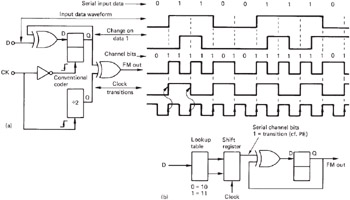3.7 Simple Codes
| | ||
| | ||
| | ||
3.7 Simple Codes
The FM code, also known as Manchester code or bi-phase mark code, shown in Figure 3.11(a) was the first practical self-clocking binary code and it is suitable for both transmission and recording. It is DC-free and very easy to encode and decode. It is the code specified for the AES/EBU digital audio interconnect standard.

Figure 3.11: FM encoding.
In FM there is always a transition at the bit-cell boundary acting as a clock. For a data one, there is an additional transition at the bit- cell centre . Figure 3.11(a) shows each data bit to be represented by two channel bits. For a data zero, they will be 10, and for a data one they will be 11. Since the first bit is always one, it conveys no information, and is responsible for the efficiency of only one-half. Since there can be two transitions for each data bit, the jitter margin can only be half a bit. The high clock content of FM does, however, mean that data recovery is possible over a wide range of bit rates; hence the use in AES/EBU. The lowest frequency in FM is due to a stream of zeros and is equal to half the bit rate. The highest frequency is due to a stream of ones, and is equal to the bit rate. Thus the fundamentals of FM are within a band of one octave. Effective equalization is generally possible over such a band . FM is not polarity-conscious and can be inverted without changing the data.
Figure 3.11(b) shows how an FM coder works. Data words are loaded into the input shift register and clocked out at the data bit rate. Each data bit is converted to two channel bits in the codebook or look-up table. These channel bits are loaded into the output register. The output register is clocked twice as fast as the input register because there are twice as many channel bits as data bits. The ratio of the two clocks is called the code rate, in this case it is a rate one-half code. Ones in the serial channel bit output represent transitions whereas zeros represent no change. The channel bits are fed to the waveform generator which is a one-bit delay, clocked at the channel bit rate, and an exclusive-OR gate. This changes state when a channel bit one is input. The result is a coded FM waveform where there is always a transition at the beginning of the data bit period, and a second optional transition whose presence indicates a one.
| | ||
| | ||
| | ||
EAN: 2147483647
Pages: 120